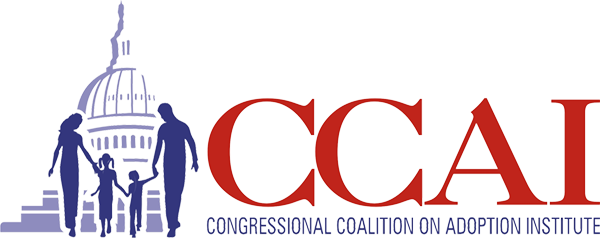Fact Sheets
U.S. ADOPTION & FOSTER CARE STATISTICS
In 2022*, according to the U.S. Department of Health and Human Services [1]:
- On any given day, over 368,000 children are living in the U.S. foster care system. Over 108,000 of these children are eligible for adoption and they will wait, on average, almost three years for an adoptive family.
- 46% of the children and youth who left foster care were reunited with their families, 6% were living with a relative, and 27% were adopted.
- More than 33,000 youth in U.S. foster care live in institutions, group homes, and other environments, instead of with a family.
- All children who left foster care in 2022 had spent an average of nearly 22 months (1.8 years) in care.
- Of the 53,665 children and youth who were adopted in 2022:
- 57% were adopted by their foster parent(s) and 33% by a relative.
- 28% were age nine years or older and the average age of adoption is six years old.
- 94% of the parents rely on adoption subsidies and/or vital post-adoption services to help meet the children's varied, and often costly, needs.
- In 2022, 18,538 (9%) emancipated, or aged out, of the U.S. foster care system, and a majority left without the emotional and financial support necessary to succeed in life that other children can receive within a family.
- Without these vital supports, they will fare poorer as a group in postsecondary educational attainment, employment, housing stability, public assistance receipt, and criminal justice system involvement.
- 70% of all youth in foster care have the desire to attend college, yet nearly 25% of youth aging out did not have a high school diploma or GED and only a mere 6% had finished a two- or four-year degree after aging out of foster care. [2]
For additional information, see these resources:
- Child Welfare Information Gateway (U.S. Department of Health and Human Services)
- Adoption and Foster Care Analysis and Reporting System (AFCARS) (U.S. Department of Health and Human Services)
- State Child Welfare Policy Data Base (Child Trends)
*FY 2022 is the most recently released AFCARS data as of February 25, 2025.
[1] AFCARS Report, #30 [The Adoption and Foster Care Analysis and Reporting System (AFCARS) collects case-level information on all children in foster care and those who have been adopted with title IV-E agency involvement. This report provides preliminary estimates of Adoption and Foster Care Analysis and Reporting System (AFCARS) data for FY 2022. As states are permitted to resubmit AFCARS data, the estimates may change over time. This report reflects all AFCARS data received as of May 9, 2023 related to AFCARS reporting periods through September 30, 2022.]
[2] Midwest Evaluation of the Adult Functioning of Former Foster Youth (Chapin Hall, 2011)
INTERCOUNTRY ADOPTION & GLOBAL CHILD WELFARE STATISTICS
Intercountry Adoption
- Between 1999 and 2014, 256,135 children were adopted by U.S. families via intercountry adoption.[1]
- According to the U.S. Department of State, U.S. families adopted 4,059 children in 2018, a 7% decline from 2017, and a 82% decline since 2004.
- In 2020, Americans adopted the highest number of children from Ukraine (211), followed by China (202), South Korea (188), Columbia (137), India (103), Bulgaria (99), and Haiti (96).[2]
For additional information, see these resources:
- FY 2023 Annual Report on Intercountry Adoption (U.S. Department of State)
- Searchable Intercountry Adoption Statistics (U.S. Department of State)
- National Council for Adoption
Global Child Welfare
- According to UNICEF, there are an estimated 132 million orphans who have lost one parent, and of these 13 million have lost both parents. The majority of these children live with their surviving parent, grandparent, or other family member.
- Research suggests that single orphans—especially those who’ve lost their mother—are much more vulnerable than non-orphans to a wide range of dangers, including HIV, teen pregnancy, depression, suicide, alcohol and drug abuse, institutionalization, malnutrition and death.[3]
- At least 2 million children live in residential care settings, but the actual number is much higher. The vast majority have at least one living parent.[4] Families often feel that placing their children into care is the only way to ensure they get an education and enough food and other essentials.[5]
- The cost of supporting a child in an orphanage is 5-10x higher than supporting a child in a family.[6]
- Studies [7] show that growing up in institutional care is not supportive of children’s development; and institutional care has been shown to produce long-term and sometimes permanent effects on children’s brains and their physical, intellectual and social-emotional development.[8]
- Children raised in orphanages have an IQ 20 points lower than their peers in foster care, according to a meta-analysis of 75 studies.[9]
- According to research from 32 European countries, which considered the “risk of harm in terms of attachment disorder, developmental delay and neural atrophy in the developing brain," [10] no child under three years of age should be placed in institutional care without a parent or primary caregiver.
- Children raised in biological, foster and adoptive families[11] demonstrate better physical, intellectual and developmental outcomes compared to children living within poor quality residential care.[12]
For additional information, see these resources:
- The State of the World’s Children 2024 (UNICEF)
- Better Care Network Library
- On Understanding Orphan Statistics (CAFO)
[1] National Council for Adoption
[2] FY 2023 Annual Report on Intercountry Adoption (U.S. Department of State)
[3] On Understanding Orphan Statistics
[5] Keeping Children Out of Harmful Institutions, Why We Should Be Investing in Family Care
[6] Faith to Action Initiative Start Here Infographic
[7] The Development and Care of Institutionally Reared Children
[8] Growth Failure in Institutionalized Children
[9] IQ of Children Growing Up in Children's Homes A Meta-Analysis on IQ Delays in Orphanages
[12] The Caregiving Context in Institution-Reared and Family-Reared Infants and Toddlers in Romania
